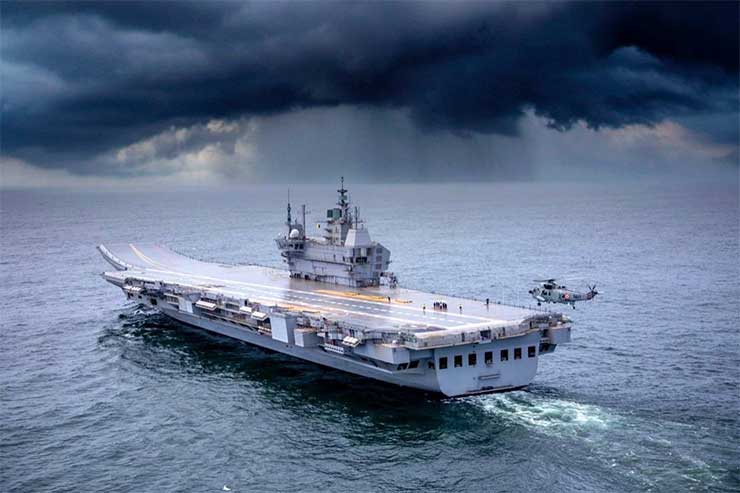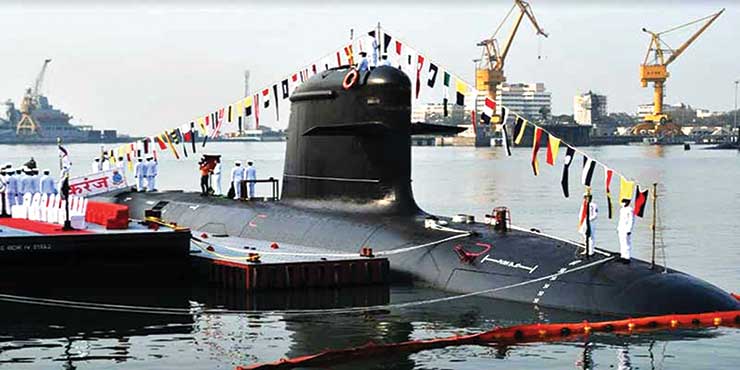‘Submarine life is not a service, but a religion’ – Igor Britanov, Captain of K-219, a Soviet submarine

Aircraft carriers and submarines are the owner’s pride, the neighbour’s envy. Both cost a pile and are too expensive to lose. Hence irrespective of whether it intends to actually use them in combat, every self-respecting country likes to have at least one or two of these ‘showpieces’ in its fleet. The simple reason behind this is that like typical white elephants Aircraft carriers and submarines cost a fortune to build/acquire or maintain and can’t be built overnight—as it takes time.
A case in point is India’s first flagship carrier INS Vikrant (R11) — a 210-meter-long Majestic class World War II vintage British aircraft carrier originally called HMS Hercules. India purchased the carrier from the British Royal Navy in 1957 and commissioned it. When HMS Hercules joined the Indian Navy as INS Vikrant (pennant number R11) in 1961 under the command of Captain Pritam Singh Mahindroo, India became the first Asian power to have an aircraft carrier. INS Vikrant was decommissioned on January 31, 1997 and harboured in Mumbai as a museum ship before being auctioned as scrap in 2014. But in the entire 40 years of service, an aircraft carrier which had the capability to carry 23 Aircraft/ Helicopters was not even once used in combat – presumably because of the fear of losing it.
In December 1961 during Operation Vijay, INS Vikrant along with two destroyers, INS Rajput and INS Kirpan was deployed off the coast of Goa. Similarly, during the 1965 Indo-Pak War INS Vikrant remained in a dry dock for refitting. Once again in 1971 INS Vikrant escorted by INS Brahmaputra, INS Beas, INS Kamorta, INS Kavaratti, and INS Khanderi was just used as a scarecrow to deter the US seventh fleet led by USS Enterprise from entering the Indian Ocean.
This irked Captain Hiranandani the Fleet Operations Officer of the Western Fleet who was awarded the Nau Sena Medal for his role in planning and implementing Op Trident and Op Python during the 1971 war. He bluntly told Admiral Nanda the then Chief of the Naval Staff, “during the 1965 war Vikrant was sitting in Bombay Harbour and did not go out to sea. If the same thing happened in 1971, Vikrant would be called a white elephant and naval aviation would be written off. Vikrant had to be seen being operational even if we didn’t fly any aircraft.”
Today, the Chinese navy has two carriers. It is already building a third and planning for two more, but India is still debating whether to go for three carriers because they are expensive and vulnerable against torpedoes.
The main argument against carriers is their cost. INS Vikramaditya, a former Russian aircraft carrier called Marshal Gorchakov cost a whopping $2.35 billion, INS Vikrant cost US$2.9 billion (without the aircraft), while INS Vishal being developed by the naval designers since 2012 is expected to cost anywhere between $6–8 billion and take 10–14 years to build. The fighter jets, helicopters and reconnaissance aircraft will cost another $5-8 billion.
According to a popular belief in the defence ministry circles, former Chief of Defence Staff General Bipin Rawat scuttled the plans for the third carrier because of budgetary constraints. His logic behind this was that the third aircraft carrier was an expensive white elephant which India could not afford as there are many other requirements crying for immediate attention. As the secretary of the Department of Military Affairs and chairman of the Chiefs of Staff Committee, General Rawat told the navy to instead focus on submarines and smaller surface ships.
This has triggered a debate about whether India should go for submarines to boost the navy’s underwater capability or develop shore-based capabilities because carriers are white elephants which cost a packet and sink to the bottom of the sea when hit by one enemy torpedo.
The dice are obviously loaded in favour of submarines which unlike aircraft carriers are comparatively economical, safer to operate, difficult to detect, and do not require a flotilla of surface vessels to accompany and defend themselves. Hence the prevalent mood in the defence ministry at the moment is to build a submarine-centric force with more submarines and develop islands in the Bay of Bengal and the Arabian Sea into “unsinkable strategic hubs.
The biggest argument against aircraft carriers is that they are visible, and hence vulnerable, against an attack using torpedoes, missiles or guns fired by ships, aircraft and submarines. Even otherwise, unlike submarines, carriers operate in battle groups—with destroyers, corvettes and frigates accompanying them—and thus have no stealth element. This however does not undermine the fact that the deterrence provided by a carrier battle group is something a submarine can never achieve.
But as they say, warfare is all about expecting the unexpected, the U.S. Navy received its biggest jolt on October 26, 2006, when a Chinese Song-class attack submarine quietly surfaced within 9 miles of USS Kitty Hawk aircraft carrier on a training exercise in the East China Sea between Japan and Taiwan. Surprisingly none of the dozen-odd warships escorting Kitty Hawk managed to detect the Chinese submarine till it surfaced. The seriousness of the incident can be judged by the fact that the Chinese vessel could have easily damaged Kitty Hawk with one of its 18 torpedoes.
The genesis of the debate (aircraft carrier v/s submarine) dates back to the geopolitical tension between the United States and the Soviet Union after World War II when the US decided to go for aircraft carriers, while the Soviet Union raised a fleet of silent submarines.
According to defence analysts, both submarines and aircraft carriers have different roles to perform and hence it is not a simple either-or situation to pick and choose one of them and dismiss or ignore the other. Aircraft carriers can help to dominate coastal areas and project power in an increasingly hostile operational environment in the Arabian Sea, Bay of Bengal and the Indian Ocean, while submarines are useful for sea denial.

A carrier battle group is a self-contained fighting unit with destroyers, frigates, corvettes and submarines which can make its presence felt as well as target submarines and coastal defences in an area of over 500 nautical miles in 24 hours. The US presently operates 11 carriers and 70 submarines. The US aircraft carriers achieved air superiority in the Gulf War.
Likewise, India too needs at least three aircraft carriers to police the Arabian Sea against Pakistan, as well as the Bay of Bengal, and practically the entire Indian Ocean from Malacca Strait to the Persian Gulf against the Chinese as well as pirates, gun-runners and terrorists.
In the past two decades, the Chinese PLA Navy has more than trebled in size. In recent times China has been working tirelessly to bridge the military imbalances with the USA which has borne fruit. The Chinese People’s Liberation Army Navy (PLAN) is all set to overtake the United States Navy which had a battle force of just 293 ships as of early 2020.
As of date, China has 121 surface warships, 56 submarines, and around 341 coastal patrol ships. These include two aircraft carriers, one cruiser, 32 destroyers, 49 frigates, 37 corvettes, and 86 missile-armed coastal patrol ships, in addition to 46 diesel-powered attack submarines, six nuclear-powered attack submarines, and four ballistic missile submarines. In addition to these, there are roughly 255 coastal patrol ships with the Chinese Coast Guard.
In contrast, the US Navy has about 162 vessels in the surface fleet and about 68 submarines. This includes a surface fleet of 11 aircraft carriers, 92 cruisers, and destroyers, in addition to 59 small surface combatants and combat logistics ships. Its submarine fleet has 50 attack submarines, 14 ballistic missile submarines, and four cruise missile submarines.
In the past decade itself, China has gone from zero to three aircraft carriers and plans to induct six more in the near future. In April 2021, the PLAN commissioned three new warships including — an amphibious assault ship, a guided missile cruiser, and a nuclear-powered ballistic missile submarine—on the same day. At the moment China is focusing on expanding its anti-submarine warfare (ASW) capabilities to protect its aircraft carriers, ballistic missile submarines, cruisers, and destroyers. Given the way it is expanding, it will be the world’s largest navy with 200 ships, and 500 aircraft by 2050.
Already China has a 4:1 advantage over the Indian Navy, which is going to amplify with each passing year. The PLAN is already far larger than the Indian Navy, and still growing at a fast pace. China is projected to have 73 attack submarines and 30 guided-missile destroyers by the end of 2022 as compared to India which has 16 submarines (15 Diesel-electric attack submarines and 1 Ballistic Missile Submarine) and 11 guided-missile destroyers (Kolkata class, Delhi class, and Rajput class).
The Indian Navy presently has a fleet of around 150 ships and submarines and 300 aircraft. Another 56 warships and six submarines are under construction in Indian shipyards. As of date, the Indian Navy’s operational fleet consists of 1 aircraft carrier, 1 amphibious transport dock, 8 landing ship tanks, 10 destroyers, 13 frigates, 1 nuclear-powered attack submarine, 1 ballistic missile submarine, 15 conventionally-powered attack submarines, 23 corvettes, one mine countermeasure vessel, 4 fleet tankers and various other auxiliary vessels and small patrol boats.
However, this is no time for an aircraft carrier v/s submarine debate, India will have to think really big if it wishes to be 200 ships, and 500 aircraft Navy by 2050.
-The writer is a seasoned media professional with over three decades of experience in print, electronic, and web media. He is presently Editor of Taazakhabar News








